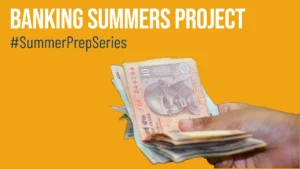How to Crack a PPO in Banking #SummerPrepSeries

With this summer prep series, we want to help you crack a PPO in your summers. And if your summers is in banking, you’re at the right place. With the emergence of fin-tech companies like PayTm, GooglePay, EarlySalary etc. the banking sector is going through a revolution, with banks like HDFC, ICICI, YES Bank etc. at the forefront of it. A career in banking is no longer a slow relaxed one but fast paced & an exciting one. To help you with this, we are going to decode a project to give you an idea about how to approach your summers project in Banking. Without further ado, let’s deep dive into the Banking project.
Summer Internship Project: Debit Card Product Enhancement
Project Brief
Currently, LES Bank offers checking account debit cards to account holders through the MasterCard and RuPay platforms only. These payment networks facilitate transactions made with their cards between the merchant’s bank and LES Bank. A chunk of the total transaction amount is deducted from the purchase by the acquirer. The biggest division is the interchange fee: the money collected by banks for their part in the transaction. These rates are set by payment networks. Since the VISA platform is not integrated with LES Bank Debit cards, LES Bank has lower bargaining power with MasterCard and account holders do not have the benefit of choice between VISA and MasterCard cards that come with their own set of offering and benefits.
A white space that exits in LES Bank’s debit card portfolio is co-branding cards that leverage synergic partnerships as well as a debit card for ultra-high net worth individual. LES Bank is looking to explore these untapped opportunities through strategic partnerships and customer centric offerings.
Objective and Deliverables
- Benchmarking of debit cards provided by 10 major banks operating in India across different attributes.
- Market research to benchmark card benefits as per cost-value tradeoff Neutralize offerings by VISA and MasterCard as benefits to card holders.
- Strategy of visa launch integration into LES bank’s debit card platform.
- Explore co-branding card opportunities and suggest synergistic partnerships.
Approach
- The project started out by studying the existing debit card market in India including payment networks and all stakeholders that take part in the transaction. Internal company reports as well as publicly available information on the web were studied for a foundational understanding on the subject.
- The debit card offerings of 10 largest banks operating in India (LES Bank’s competitors) were carefully studied and mapped as per price points and value provided to card holders. This research was majorly done though bank portals.
- White spaces and gaps were identified in the debit card market where LES Bank did not have a presence, but competitors were present to cater to consumer’s needs. Eg) Lxis Bank provided a high value Burgandi Card for ultra-high net worth individuals. This offering was absent in LES Bank’s card portfolio.
- SIn in-death analysis of LES Bank debit cards’ benefits was done which was used for a cost-value analysis to determine which benefits to add, replace or eliminate for each card type and its target customer. The cost parameters consisted of annual fee and initial fee while the value parameters were sought from primary research.
- Primary research in the form of interviewing bank branch managers as well as existing customers generated insights on most used and desirable card benefits. Upon visits to brank branches; managers were asked what their customers were looking for most in a debit card and other customer recruiting questions through a survey. Customers were asked to rate several card benefits from most to least desirable.
- It was found that certain niche benefits such as car rental coupons were not being utilized by customers and broader benefits that came with payment platforms such as airport lounge access were the most desirable.
- An excel model was made to gauge white spaces within the cost value framework and 3/5 of VISA’s debit card offerings were found suitable to onboard: Signature, Infinite and Platinum.
- Meetings with the internal digital banking team and with VISA initiated talks to onboard the payment network. These talks were however suspended mid-way after LES Banks’ high risk financial exposure came to light and the senior management decided against the deal as current products would have required changes in backend and frontend operations in line with VISA integration.
- After suspension of talks with VISA the project focused on co-branding cards which was another white space that LES bank where had no presence, but competition did. Eg) Lxis bank and Qlipkart’s co-branded card. This card provided customers cashbacks and extra savings on purchases made on Qlipkart and all its subsidiaries along with saving on fuel, movie ticket booking etc.
- Synergistic partnerships of several E-commerce players with LES Bank were explored and co-branded card offerings were suggested on the basis of unique potential partnerships.
- A cashback card model was found to me most desirable from primary research and a model for the same was created with different cashback percentages offered for transactions on platforms of co-branded merchants, preferred partner merchants and all other merchants.
Stakeholders
External: Account holders & transaction platform players
Internal: Marketing team, digital banking team & branch managers
End Result
- Debit card offerings benchmarking of 10 major banks in India done
- Cost value model created to identify white spaces in LES Bank’s debit card portfolio: debit card for ultra-high value net worth individuals
- VISA platform and LES Bank current products synergy explored
- Co-branding cards partnerships suggested
Challenges
- Being a marketing intern in a finance focused company led me weigh various alternatives in a twofold manner. One, from the perspective of whether it made business sense financially and the other from the perspective of being consumer centric and giving the consumer what they desired. This was especially true for choosing to take or trash some of the card holding benefits that were a shared cost burden between payment networks and LES Bank. A cost value analysis study was carried out using historic data of benefits used by customers and through primary research: by speaking to card holders both potential and current in order to overcome this decision making hurdle.
- Data of internal active users was also hard to come by especially in a bank that is privy to customer’s confidential information. Adhering to strict compliance in every request for data from internal departments was a challenge. Reliance was on primary research and directly speaking to customers to substitute for data that was unavailable or could not be shared.
End Review Questions
Project specific
- Elaborate how you came up with the rating scale? Did each factor have the same weightage?
- Discussion on pricing of product and key differentiators for a value based pricing approach.
- What were the challenges you faced in each phase of the project?
- You still have 1 week remaining in the internship, what would you like to do?
- What did you understand about the sales channel?
HR + General questions
- How was your experience travelling to tier 2 and tier 3 towns and engaging with intermediaries in the sales channels?
- Will you be comfortable pursuing a career in sales?
- Why Ocian Paints?
Now this is just one type of project you might get. Although, projects across sectors tend to have a lot in common. So make sure, you keep an eye out for other sector projects as well.
This article was written by Sneha Roy from FMS.











